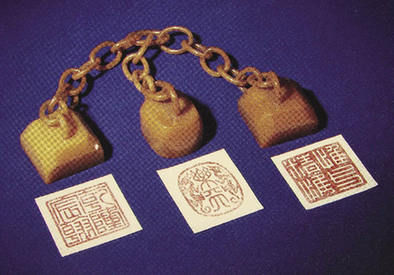|
Invaluable Stones
 |
| The three Tianhuang seals chained together. |
Some stones are more precious than gold, such as Fujian's Tianhuang. In the Qing Dynasty, Fujian's governor sent Emperor Qianlong a set of three seals chained together, made from one piece of Tianhuang. The emperor loved it very much and carefully handed it down as a treasure of the imperial family. When the Qing Dynasty collapsed, the last emperor Puyi sewed the three seals inside his cotton-padded robe and spirited them out of the palace.
It is said the stone was produced within a farm field of less than one square kilometer in Fujian's Shoushan. Since it is yellowish in color, the stone is named Tianhuang, or Field Yellow. Its soft texture made it top-grade material for carving. During the Ming and Qing dynasties, this stone was popular for imperial tributes and was nicknamed "Imperial Stone." It is said that the field produced only 100 kilograms of Tianhuang before it was exhausted. Surviving Tianhuang stones are hence extremely valuable. In 2008, a 74.4-gram Tianhuang animal sculpture sold for RMB 1.008 million, making it much more expensive than gold.
Chicken blood stone produced in Zhejiang's Changhua is comparable to Tianhuang in value, and the word "mad" is often used to describe the prices it fetches.
Through the millennia, stone has accompanied humankind through all the ups and downs of the temporal world.
| 